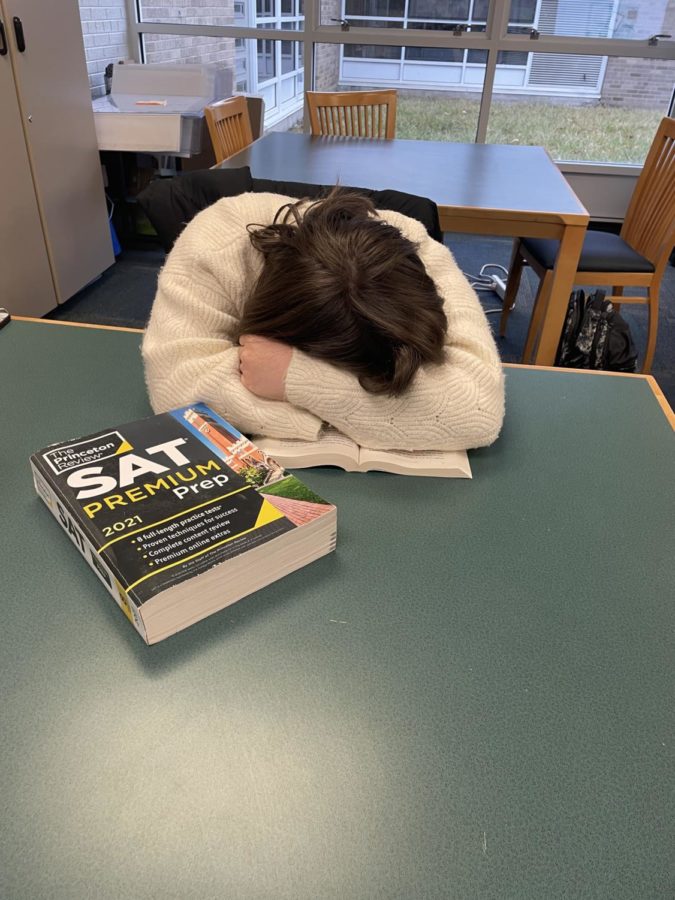Standardized Testing Does More Harm Than Good
Senior Reese Culbertson reenacts the long hours of studying she completed for the SAT. She recounts the numerous hours she spent studying the outdated and extensive subjects covered on the SAT.
I look out the window of my dad’s car and wait for the sound of his disapproving sigh.
“Well…you tried. I guess that’s all that really matters,” he says.
Between his deep sigh and the reluctance in his tone, I can tell he doesn’t really mean it. The part that really bugs me about all of this is the fact that he’s right; I tried my hardest — and I still didn’t improve my score. The car hits 75 mph, the ground below us moves almost as fast as my racing thoughts.
Maybe I’m just dumb. I’m never going to get into a good college now. Everything I’ve worked so hard for is all for nothing. Maybe I’m just not good enough.
The thoughts have now made their way down to my stomach and I start to feel physically ill. I try to distract myself by directing my attention to the early-fall scenery, but the bad thoughts still overpower the orange hues and falling leaves.
I close my eyes and wish that I could’ve done better. I hope this test won’t determine my future.
A 17-year-old shouldn’t feel this way. This immense amount of pressure shouldn’t be expected of anyone — let alone children. Standardized tests have not only shattered the self esteem of thousands of kids, they also exacerbate the wealth gap among students. While it is beneficial that many universities have decided to turn to “test optional”, I suggest that we ditch the outdated tests for good.
Speaking from personal experience, kids in wealthier communities have an advantage on the SAT/ACT. From personal tutors and test-prep to well-funded schools, kids in these communities are presented with more opportunities than others. Oakland County is no exception.
“I’ve been doing SAT test-prep since freshman year,” said a friend of mine. That friend went on to score a very high score on the SAT.
I myself have gone through test-prep for the ACT. While test-prep is a normal after-school activity here at Groves, that is not the case for many students in lower-income communities. This pattern of only wealthy students receiving tutoring furthers the inequalities lower-income students face. A study in an article by Forbes states;
“Students with family income of $100,000 or more are more than twice as likely as students with family income under $50,000 to have combined SAT test scores of 1400 to 1600” (Kantrowitz, How Admissions Tests Discriminate Against Low-Income And Minority Student Admissions At Selective Colleges).

This advantage limits post-high school options for students coming from low-income households. An article by The Atlantic states that according to federal college data,
“Nearly 70 percent of students in the nation’s most selective colleges are from that top socioeconomic quartile…”. (Zinshteyn, The Growing College-Degree Wealth Gap).
This disadvantage heavily decreases the amount of degrees handed out to students from low-income families. Denying students the same opportunities to reach these goals solely based on their socioeconomic background denies them access to higher paying careers in the future.
The Atlantic stated “Graduates who hailed from households with incomes of at least $116,000—the top quarter—represented more than half of all the degrees awarded in 2014 among 24-year-olds. Students from households that earned less than $35,000—the lowest quarter—represented just 10 percent of all the degrees awarded” (Kantrowitz, How Admissions Tests Discriminate Against Low-Income And Minority Student Admissions At Selective Colleges).
Standardized testing is not only unfair, it also damages mental health. I’ve noticed a clear difference in the stress levels of my peers going into junior and senior year.
“I had a mental breakdown in economics class today,” said another friend.
That same friend felt so overwhelmed that she skipped school a few days later.
A classmate in my Excel class can’t keep her eyes open and sleeps through most lectures. She works after school nearly every day and stays up late trying to complete all of her missing assignments. I personally have felt the pressures of highschool. Staying up until midnight to study, only to wake up at 6:30am to do it all over again. By the time the weekend rolls around, I’m exhausted and I sleep in until noon.
Standardized tests only exacerbate the already elevated stress levels in students. Knowing that this one score could be the final say in if one can get into their dream school is enough to drive anyone crazy — let alone young students who already have so much pressure on them.
Harvard graduate Christina Simpson provides evidence to show how these high levels of stress can not only affect one’s mental health, they can also hinder one’s physical health.
A survey by the American Psychological Association “reported stress levels far above what they view as healthy, and on average, teens’ reported stress levels were higher than adults’ reported stress levels…” (Simpson, Effects of Standardized Testing on Students’ Well-Being).
Standardized test-related stress can also cause very real, physical symptoms.
“Health consequences associated with standardized testing were cited as including stomach aches and vomiting, headaches, sleep problems, depression, attendance problems, and acting out,” (Simpson, Effects of Standardized Testing on Students’ Well-Being).
So while the school districts scramble to find the causes in the rise of depression and class absences, they often forget to look in a mirror. Overworking students in school and standardized testing are some of the most recent culprits of causing depression and behavioral issues in adolescents. Additionally, standardized testing gives wealthy students a leg-up in the college admissions process. This disadvantage will affect their future careers and well-being. Therefore, it only makes sense to eliminate the standardized testing system — and to stop overworking students during the school year.
Your donation will support the student journalists of Wylie E. Groves High School. Your contribution will allow us to purchase equipment and cover our annual website hosting costs.

Leah Salzenstein, senior, is a managing editor for the Scriptor. She loves to write opinion and new feature pieces. Some of her published articles include...

























































